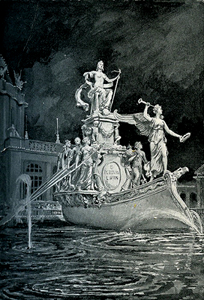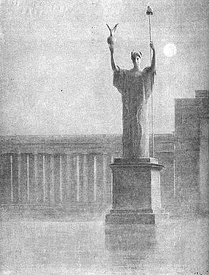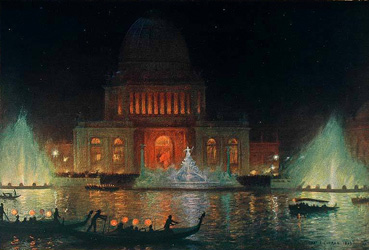

![]()
![]()
![]()
![]()
(Originally published in Lippincott's Magazine (Aug. 1893).
According to his recent biographer, Julian Hawthorne was the "prodigal son" of the American literary giant Nathaniel Hawthorne.
Although a prolific writer in any number of literary genres, Julian was overshadowed by his famous father and, later in life, ended
up in prison for several months for fraud. Yet this is also the man who wrote two personal histories of his father's life and his father's famous literary circle (which included
such luminaries as Henry David Thoreau and Ralph Waldo Emerson). His output ranged from novels (26 of them!) and children's books to
journalism about a devastating plague in India and interviews with contemporary scientists like Nikola Tesla and Thomas Edison.
The following excerpts are Hawthorne's
impressionistic descriptions of the Grand Basin sculpture and night-time electric light displays--called "illuminations"--featured at the Columbian World's Fair 1893. Whether his
"Lady of the Lake" alludes to Sir Walter Scott's very popular poem by that name or the "lady" of Arthurian legend who bestowed the magic sword Excalibur upon a youthful
King Arthur, Hawthorne obviously intends her to be, he implies, the emblem of the "vibrations" of "spiritual beauty which we believe in, but can never grasp."
![]()
![]()

Central Portion of the MacMonnies
Fountain--Effect of Electric
Light by Will H. Low.

Daniel Chester French's Statue of
'The Republic,' an Hour after Sunrise
by Jean Andre Castaigne.
This title ["Lady of the Lake"] I apply to the enchanting personage who sits on a sort of curule chair, with high, semicircular back, on the poop of the vessel which, propelled by eight maidens only less
lovely than the Lady herself, seems to speed forward from the head of the Lagoon at the World’s Fair.[1]
I cannot enough admire this creation of the sculptor’s genius. The Lady’s attire consists of a robe or toga, worn round the body, and supplemented by a light scarf, to envelop the
neck and head. But the disposition of this simple costume has been modified by circumstances.
You are to understand that the Old World has just arrived at the Fair, and is at this moment making its entry by way of the triumphal arch in the centre of the great marble colonnade
fronting on the Lake. Descrying them from afar, the Lady has cried out “Forward!” to her eight oarswomen,—or gondoliers, rather; for they ply their long oars standing,—and the boat
has leaped onward responsive to the impulse given it. At the same moment, the Lady, inspired with emotions of welcome and lofty excitement, has lifted her head and erected her whole
body in the chair. Her left arm lies along the high back of it; her right hand holds her emblem of divinity; her bosom is expanded, and her crossed feet just touch the deck. Meanwhile,
her toga has slipped down, leaving her white body bare as far as below her loins; and the scarf, in the breeze of her going, flutters far out behind, and will be gone altogether in
another moment. The figure thus fully and unconsciously revealed is divinely beautiful, and its extraordinary erectness gives it a special charm,—the charm of immortal life, youth,
and vigor. Seen from whatever point of view, it develops fresh delightfulness; I can recall no ancient or modern statue which seems at once more alive, more severely statuesque, and
more beautiful. The little vessel dashes onward; the tritons with their steeds of the sea disport themselves around it; on the prow, a damsel sets a trumpet to her lips; the Lagoon,
with its marble margins, and the surrounding cliffs of snowy architecture, extend before it; the blue sky is above, the free air all about it. I have no fault to find with the
composition: it is worthy of its place, as the central feature of the most superb architectural scene that was ever—I am bold to affirm—beheld in this world. I know no other design
of a fountain that is to be for a moment compared with this, and glad am I to have lived to see it.
At the other end of the Lagoon stands the colossal golden figure of the Republic, with uplifted hands. It is a work on which any artist might be content to rest his
reputation. It is massive, stately, simple, and severe. The heavy robe falls in straight folds, like those of the early Greek statues. The pose is at once the simplest possible, and
the most impressive. So should stand the human symbol of the mightiest of nations. It is as dignified as a tower, and as splendid as a goddess. I regret only that the head and the
arms are gilded [2]. In the great Grecian statue of Pallas the garments were golden, but the face was of ivory. These golden features of the Republic are marred in their effect by
the incident and reflected lights, and much of their beauty is lost.
[. . .]
I am glad I first came here in winter, while the interior of the Buildings was as yet clear of “exhibits.” Those who have never seen their stupendous emptiness have lost a unique
sensation. Those illimitable, bare floors, stretching away to horizons on all sides, with only, insignificant atomies of men crawling over them here and there, have now disappeared
under the piled-up confusion of the minor structures. The impression now conveyed is that of little cities, walled in and roofed over. Necessarily, all architectural harmony is at
an end. You must give that up, and apply your mind to detail. Of course, no conceivable “exhibit” could compare in beauty with the vast white palaces which house them. They are on
another plane altogether. But, when you have adapted yourself to the situation, there is no denying that the “exhibits” are of absorbing interest. They grow upon you; they exhaust
you, and yet they lead you on. You cover miles of ground without knowing it—until you get home! On a careful calculation, I found that I walked certainly not less than fifteen miles
during each day of my visits to the Fair. You can be wheeled in a chair, if you like; but no one who has both a soul and legs will endure to do that. Many who have only legs, or only
a soul, do.
The fact is, the Fair is both too large, and too small. It is too small for the exhibitors, and too large for the visitors. No one pair of eyes can even see it all in six months: as
to digesting what you see, that is out of the question. For here are amassed samples of everything that the civilized world produces. There is too much of it; but it cannot be helped,
for the reason is that the civilized world has grown too large. It is so large that the barest epitome of it is practically unmanageable. In future years it will be worse still; and
the only solution of the difficulty that I can propose is, that a continuous World’s Fair should be established, in some convenient place, permanently accessible to the public, and
to be enlarged and modified as occasion may demand. When our flying-machines [10] are perfected, we can get to the central point easily, and the only precaution to be observed will
be to select a site where the Fair can indefinitely expand.
[Parts II and III--omitted]
But let us forget all our troubles, and solace ourselves with the incomparable loveliness of the illuminations.
The illumination lasts from eight o’clock till eleven, and occurs thrice a week. I went on a Saturday. It was a soft and luxurious evening, with scarce a breath of wind, and what
there was from the south. The moon, nearly full, hung aloft in mid-heaven, silvery in a dark-blue velvet sky. The grounds were well filled: about one hundred thousand persons were
present, according to the next morning’s papers. But most of this crowd was, of course, assembled in the great court or quadrangle containing the Lagoon, and bounded by the Manufactures
and Electrical Buildings on one side, the Agricultural on the opposite side, the colonnade on the Lake end, and the Administration facing it.
The manner of the illumination was simple and almost severe, not erring on the side of profusion; and yet the effect, as enhanced by the Lagoon, was rich in the extreme. A line of
incandescent electric lamps followed the long cornices of the buildings entirely round the quadrangle, rising to define the angles of the pediments and entablatures, and curving over
the arched entrance of the Electrical Building. Another long line of these lamps completely encircled the margin of the Lagoon, at a height of four or five feet above the surface of
the water. On the broad esplanade, between these two lines of light, stood an unbroken array of tall lamp-posts, each supporting a Brush electric lamp. These, too, formed a ring
round the Lagoon.

The Administration Building and Electric Fountains at Night.
by Charles Curran.
The vertical ribs of the great dome of the Administration Building were marked by incandescent lamps, and the dome was surmounted by a crown of them. On slender pillars surrounding
its base were flaring torches of gas. Electric lamps likewise defined the main architectural features of the facade. Finally, beneath the arch of the colonnade on the Lake, red calcium
lights were kept constantly burning, shedding over the interior of the passage a rosy glow. The interiors of all the Buildings were also faintly luminous, and a white light shone
softly through the glass roof of the great Manufactures structure. The Palace of Agriculture, which has a colonnade running all along it, was furnished with lights within the line of
columns, but invisible to the spectator. The walls beyond the columns are tinted a pale salmon hue, which was illumined by these lights, and against which the white pillars defined
themselves. On the dome of this building stands the golden Diana, ravished from the tower of the New York Madison Garden: at her feet was a ring of lamps, which cast a gleam upwards
over her graceful figure.
Such was the arrangement, easily described; but the effect can be realized only by seeing it. The Lagoon, which cannot be less than a quarter of a mile long and about two hundred yards
wide, was filled with gondolas and electric and steam launches, which circulated round and round, disturbing the otherwise placid surface of the water, and silhouetting their dark,
graceful forms against the omnipresent brightness. Some of them were hung with many-colored Japanese lanterns. They were filled with people, and one carried a chorus of male voices,
singing delectably. As you walked round the broad terraces surrounding the Lagoon, the ruffled water made a confused splendor of the reflected lights. The incandescent lamps, which
looked like threaded beads of living gold, mingled there with the silvery reflections of the Brush lamps, so that the shining surface seemed to flash and ripple with the welded
metals.
The massive golden statue of the Republic which rises majestic at the lower end of the Lagoon caught the radiance upon its stately sides, and, as I stood gazing up at it, the moon
stood just above its head, and seemed to make the figure also a denizen of the sky. From every point of view the long level lines of light charmed and enchanted the eye, and led the
gaze onward to the splendid dome, whence it fell again to the fluctuating glory of the Lagoon, with its movements and its song. The harmony was on a scale so vast that the mind had
to exert itself to compass it.
This, however, was not all. From the two stands on either side of the Administration Building, orchestras discoursed triumphant music in alternation, and the multitude gathered round,
walking from one to the other as each took up the strain. The throbbing melody filled the mighty space, and was re-echoed from the marble cliffs, and swept in lovely pulsations over
the Lagoon. And while it sounded, the architecture looked nobler and more beautiful, as if the music had given it a soul, or it were the visible embodiment of the music. And now, as
if in response to a summons, the three fountains which crown the Lagoon leaped into rushing and up-reaching life; those to the right and left were illuminated from within by electric
lights, which changed their hue from white to rose, and thence to azure. From various high coignes of vantage the long, keen rays of search-lights struck across the dark, and lit
upon the golden Diana on her dome, and upon the seated figure in the barge of the fountain, and upon the heights of the Administration Building, and wandered over the masses of
the crowd, and over the flitting gondolas. Point after point awoke to life and distinctness as it passed.
I got into a boat, and steamed through the rosy arch of the colonnade, and out on the broad, dark expanse of the boundless Lake. The water was smooth, and lit only by the quivering
image of the moon. As we got our offing, the group of buildings on the shore assumed dim shapes of beauty; and other boats, beyond us and on either side, and lighted with many-colored
lamps from stem to stern, hung like enormous jewels on the cheek of night. A search-light from the east, plunging at hazard through the transparent gloom, discovered here a ship
and there a barge which the darkness had hidden. They started into sudden, intense visibility, and the next moment vanished again, like ghosts that illude the eye and then are no
more.
It was a banquet of royal beauty. Returning at last to the Lagoon, I mounted flight after flight of stairs to the base of the Administration dome. Here, an undefined horizon, twinkling
afar with lights, spread round on every side: below, in front, were the crowds, and the lines of lamps, the fountains and the music. I stayed and looked and listened long; for never
have I beheld a fairer scene: unsentient matter seemed to dissolve and flow into poetry, and to vibrate with the spiritual beauty which we believe in, but can never grasp.
Source: Hawthorne's "Lady of the Lake"
![]()
![]()
Go to Frederick Jackson Turner's Frontier Thesis
Return to Musicians/Writers/Activists
Return to Site Index
![]()
![]()
Sculpture, top of page:
Adelaide Johnson's "The Portrait Monument"
(Elizabeth Cady
Stanton, Susan B. Anthony, Lucretia Mott), 1892, 1920.
Return to Nichols Home Page
Suggestions/Comments: knichols11@cox.net
Posted: 4-15-15; Updated: 4-02-19